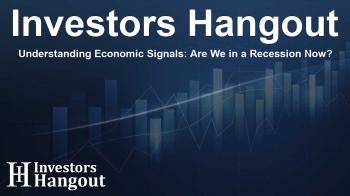Understanding Economic Signals: Are We in a Recession Now?

Analyzing Jerome Powell's Recession Remarks
During a recent press conference, Jerome Powell was asked if he believes we’ve successfully avoided a recession. His response, suggesting that it’s 'pretty clear' we have, raises questions for many analysts. Contrary to his viewpoint, some interpret the macroeconomic landscape as leaning toward a recessionary phase, with several indicators suggesting caution.
Insights from Yield Curves
The concept of yield curve inversion has been a hot topic, often associated with impending recessions. While mainstream media focused on the negative implications of this inversion, the subsequent steepening of yield curves can reflect different economic conditions. Analysts have observed that the steepening of the 10yr-2yr yield curve has resumed recently, indicating potential economic shifts.
Historically, steepening yield curves have preceded economic downturns, as seen in bear markets in the years 2000 and 2007. The current scenario shows a similar trajectory, where yield curves are steepening amid a mix of disinflationary pressures and slight inflationary signals. This duality is critical, as it can indicate alternating market conditions.
Understanding the Yield Curve Dynamics
The 10year-2year yield curve’s behavior is significant in understanding potential economic shifts. Inversions can lend themselves to misleading interpretations if not considered alongside broader economic indicators. As seen earlier, a steepening can signify an approaching market downturn.
The Bigger Picture: Economic Indicators
Current market conditions also point to crucial factors outside yield curves. Observations from past bear markets indicate that periods of economic turmoil are often preceded by specific market signals. An informed analysis requires looking at various economic indicators, including the Gold/Silver Ratio (GSR) and the strength of the US Dollar, to gauge the broader economic environment.
The Gold/Silver Ratio and Market Implications
A rising Gold/Silver ratio typically implies a stronger dollar and can reflect severe liquidity constraints within the market. When gold remains resilient while silver prices drop, it signifies underlying economic dynamics that investors need to watch closely. The relationship between these two metals reveals much about market sentiment and potential economic trajectories.
Assessing the State of the Dollar and GSR
The US Dollar's performance remains crucial for market health. A sustained bullish trend, alongside a stable GSR, can suggest potential for a year-end market rally, often referred to as a 'Santa Claus rally', that could carry into the following year. However, should the dollar and GSR exhibit impulsive movements, market participants may prefer to lock in gains and manage risk ahead of possible downturns.
Conclusion: Preparing for Potential Economic Shifts
Ultimately, the indicators being observed do not unanimously suggest that a recession has been avoided. Instead, there is a mix of bullish energy currently in the markets, but that doesn’t eliminate the possibility of an economic downturn looming on the horizon. Analysts continue to monitor key indicators and signals that may point to future market behavior and economic conditions.
Frequently Asked Questions
What did Jerome Powell say about recession indications?
Jerome Powell suggested that it's 'pretty clear' that a recession has been avoided, a statement that is being questioned by some analysts.
What does yield curve steepening indicate?
Yield curve steepening can indicate potential incoming economic shifts, often pointing toward a possible recession as observed in past market behaviors.
How does the Gold/Silver Ratio influence market predictions?
The Gold/Silver Ratio serves as an essential indicator of market sentiment and liquidity, providing insight into potential economic conditions.
What role does the US Dollar play in economic outlook?
The performance of the US Dollar is a significant marker of market health and can influence various economic indicators, shaping investor sentiment.
Should investors be concerned about current market signals?
Current indicators suggest a cautious approach for investors, as market conditions may indicate an impending shift toward recession despite recent bullish energy.
About The Author
Contact Hannah Lewis privately here. Or send an email with ATTN: Hannah Lewis as the subject to contact@investorshangout.com.
About Investors Hangout
Investors Hangout is a leading online stock forum for financial discussion and learning, offering a wide range of free tools and resources. It draws in traders of all levels, who exchange market knowledge, investigate trading tactics, and keep an eye on industry developments in real time. Featuring financial articles, stock message boards, quotes, charts, company profiles, and live news updates. Through cooperative learning and a wealth of informational resources, it helps users from novices creating their first portfolios to experts honing their techniques. Join Investors Hangout today: https://investorshangout.com/
The content of this article is based on factual, publicly available information and does not represent legal, financial, or investment advice. Investors Hangout does not offer financial advice, and the author is not a licensed financial advisor. Consult a qualified advisor before making any financial or investment decisions based on this article. This article should not be considered advice to purchase, sell, or hold any securities or other investments. If any of the material provided here is inaccurate, please contact us for corrections.

